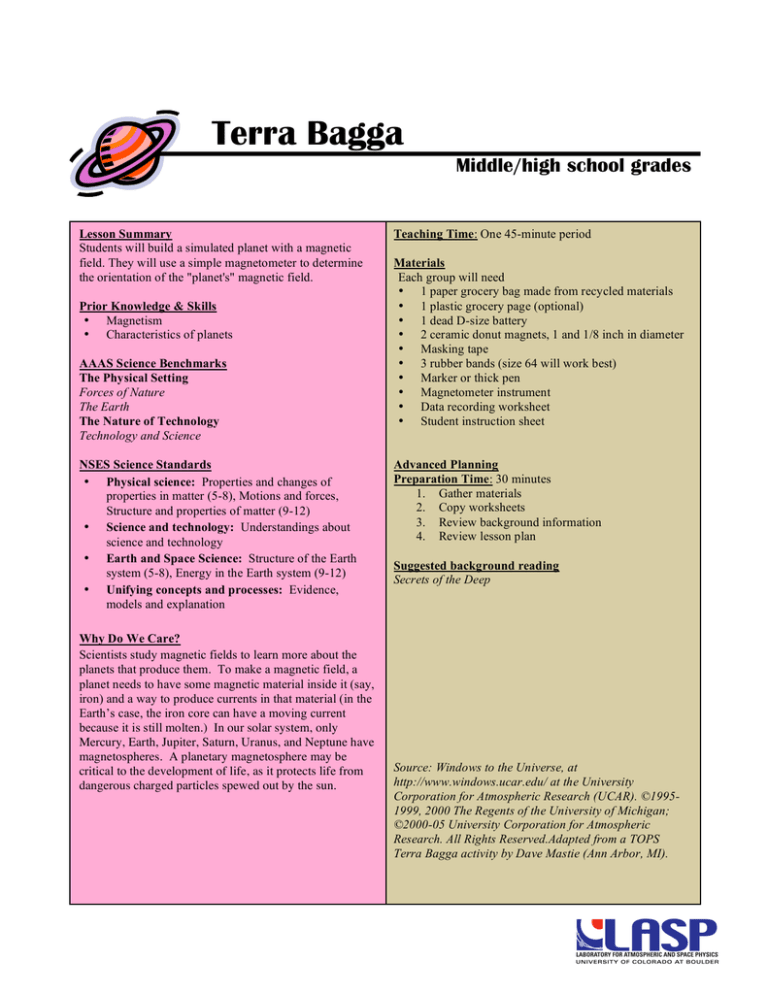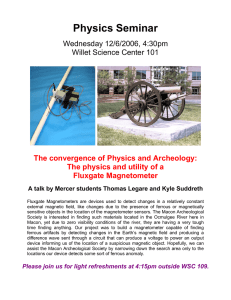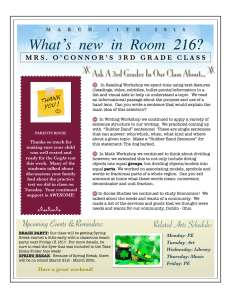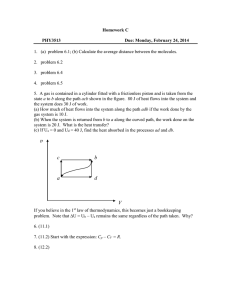
Terra Bagga
Middle/high school grades
Lesson Summary
Students will build a simulated planet with a magnetic
field. They will use a simple magnetometer to determine
the orientation of the "planet's" magnetic field.
Prior Knowledge & Skills
• Magnetism
• Characteristics of planets
AAAS Science Benchmarks
The Physical Setting
Forces of Nature
The Earth
The Nature of Technology
Technology and Science
NSES Science Standards
• Physical science: Properties and changes of
properties in matter (5-8), Motions and forces,
Structure and properties of matter (9-12)
• Science and technology: Understandings about
science and technology
• Earth and Space Science: Structure of the Earth
system (5-8), Energy in the Earth system (9-12)
• Unifying concepts and processes: Evidence,
models and explanation
Why Do We Care?
Scientists study magnetic fields to learn more about the
planets that produce them. To make a magnetic field, a
planet needs to have some magnetic material inside it (say,
iron) and a way to produce currents in that material (in the
Earth’s case, the iron core can have a moving current
because it is still molten.) In our solar system, only
Mercury, Earth, Jupiter, Saturn, Uranus, and Neptune have
magnetospheres. A planetary magnetosphere may be
critical to the development of life, as it protects life from
dangerous charged particles spewed out by the sun.
Teaching Time: One 45-minute period
Materials
Each group will need
• 1 paper grocery bag made from recycled materials
• 1 plastic grocery page (optional)
• 1 dead D-size battery
• 2 ceramic donut magnets, 1 and 1/8 inch in diameter
• Masking tape
• 3 rubber bands (size 64 will work best)
• Marker or thick pen
• Magnetometer instrument
• Data recording worksheet
• Student instruction sheet
Advanced Planning
Preparation Time: 30 minutes
1. Gather materials
2. Copy worksheets
3. Review background information
4. Review lesson plan
Suggested background reading
Secrets of the Deep
Source: Windows to the Universe, at
http://www.windows.ucar.edu/ at the University
Corporation for Atmospheric Research (UCAR). ©19951999, 2000 The Regents of the University of Michigan;
©2000-05 University Corporation for Atmospheric
Research. All Rights Reserved.Adapted from a TOPS
Terra Bagga activity by Dave Mastie (Ann Arbor, MI).
Terra Bagga Activity Using a Magnetometer
Summary
Students will build a simulated planet with a magnetic field. They will use a
simple magnetometer to determine the orientation of the "planet's" magnetic field.
Source
Adapted from a TOPS Terra Bagga activity by Dave Mastie (Ann Arbor, MI).
Grade level
5-12
Time
30-45 minutes
Student Learning Outcomes
• Students will construct a simulated planet with
a magnetic field.
• Students will be able to label the equator and
lines of longitude on a globe.
• Students will determine the orientation of a
magnetic field using a magnetometer.
Lesson format
Model/Hands-on Activity/Discussion
National Standards Addressed
• K-12: Unifying Concepts & Processes Standard: Evidence, models, and explanation
• K-4: Content Standard B: Physical Science: Light, heat, electricity, and
magnetism
• K-4: Content Standard D: Earth and Space Science: Objects in the sky
• K-4: Content Standard E: Science and Technology: Understanding about
science and technology
• 5-8: Content Standard B: Physical Science: Properties and changes of
properties in matter & Motions and forces
• 5-8: Content Standard D: Earth and Space Science: Structure of the earth
system & Earth in the solar system
• 5-8: Content Standard E: Science and Technology: Understandings about
science and technology
• 9-12: Content Standard B: Physical Science: Structure and properties of
matter & Motions and forces
• 9-12: Content Standard D: Earth and Space Science: Energy in the earth
system
• 9-12: Content Standard E: Science and Technology: Understandings
about science and technology
MATERIALS AND WORKSHEETS
• 1 paper grocery bag made from recycled materials (these bags will break
down the best)
• one plastic grocery bag (optional)
• 1 dead D-size battery
• 2 ceramic donut magnets, 1 and 1/8 inch in diameter
• masking tape
• 3 rubber bands (size 64 will work best)
• marker or thick pen
• magnetometer instrument (see Magnetometer Activity,
http://www.windows.ucar.edu/tour/link=/teacher_resources/magnetism/tea
ch_magnetometer.html, for instructions about building a simple,
inexpensive magnetometer)
Worksheets
• Worksheet for recording data about magnetic fields of "planets" that
students explore
• Instructions about building Terrabagga for Students
DIRECTIONS
Overview: Students will build a simulated planet with a magnetic core. The core
will consist of a battery with "donut" magnets taped onto the ends, creating the
equivalent of a larger bar magnet. The core will be wrapped in a crumpled paper
bag (the bulk of the "planet"). The bag will be held shut by rubber bands, which
will also serve as latitude and longitude lines dividing the "planet" into eight
segments. The students will use a magnetometer to determine which octant of
the planet the north and south magnet poles are beneath. They will record this
info, then swap planets with other groups so they can repeat the "finding the
poles" process on several different "planets".
Refer to our Terrabagga photos to see pictures of the stages of this procedure:
http://www.windows.ucar.edu/tour/link=/teacher_resources/terra_photos.html
1. You may wish to demonstrate the process of building a "planet" and
finding the orientation of its magnetic field to your students first, and then
having them do the process themselves.
2. The first step in building a "planet" with a magnetic field in it is to create
the dipolar magnet that will go inside the world. Take the two magnets and
place them on top of each other so that the magnets are attracted to each
other. Now without flipping either magnet over, place the top magnet on
the top of the battery. Tape this magnet in place. Place the bottom magnet
on the bottom of the battery (remember, the side that was facing up,
should now be against the casing of the battery). Tape this magnet in
place.
3. Next turn the paper bag inside out. This creates a clean surface that will
be labeled later on. Work the bag by crumpling it and folding it.
4. When the bag is turned inside out and is pretty workable, place your
battery (with the magnets taped on) inside the paper bag. It does not
matter which way the battery is facing. Work the paper bag around the
battery to create a nice smooth (fairly round) world. Try to center the
battery/magnet in the middle of the "planet". If one pole is too close to the
surface, the opposite pole may be buried too deeply to sense with the
magnetometer. You may wish to use the optional plastic bag to add extra
padding to the "planet's" interior to help center the magnetic core, or you
may want to "double-bag" the "core" to accomplish the same result (i.e.
first wrap the plastic bag around the "core", then surround both with the
paper bag).
5. Now it's time to put the rubber band markers on your world. The first
rubber band can just be placed wherever it's most needed to hold your
world together. Just stretch the rubber band around your world.
6. Now stretch one more rubber band across your world. This rubber band
should meet at right angles with the first rubber band so that your world is
now split into 4 equal segments. Pick one of the intersections of your two
rubber bands to be the geographic north pole. Make sure the north pole is
facing up.
7. Now it's time to label parts of your world. Note that the rubber bands make
a "X" when looking down on the north pole. The four "branches" represent
four lines of longitude separated by 90°; the prime meridian at 0°, 90° west
longitude, the international dateline at 180°, and 270° west longitude
(which is the same as 90 east longitude). Pick one of the two rubber bands
to label first (either one - it doesn't matter which you do first). Use the
marker to write a zero on the rubber band on one side of the North Pole,
then write "180" on the same rubber band on the opposite side of the
North Pole.
8. Now turn your world so that you are looking at the prime meridian (the line
of zero longitude) with the "North Pole" up. Everything east (right) of the
prime meridian all the way to the international dateline is the eastern
hemisphere. Everything west (left) of the prime meridian all the way to the
international dateline is the western hemisphere. Label the part of your
(unlabelled) rubber band that lies in the eastern hemisphere 90 E,
because it represents the longitude of 90 degrees east. Label the part of
that same rubber band that lies in the western hemisphere, 90 W, because
it represents the longitude of 90 degrees west.
9. Next add the third rubber band to your world. This rubber band should
stretch across both of the other rubber bands meeting those rubber bands
at right angles. This rubber band is your world's equator, so it should be
stretching across the middle of your world. Once that rubber band is in
place, label that rubber band "equator". Everything above equator towards
the geographic north pole is the northern hemisphere and everything to
the south of the equator is the southern hemisphere. Your world should
now have eight equal segments.
10. It's time to label the 8 segments. The segments in the northern
hemisphere should be labeled 1-4 with segment 1 being between 0 and 90
E. Segment 2 is then between 90 E and 180, segment 3 is between 180
and 90 W and segment 4 should end up being between 90 W and 0. The
segments in the southern hemisphere should be labeled 5-8 with segment
5 being below segment 1 and so on so that segment 8 is below segment
4.
11. Have students make up a name for their "planets". Have them write the
"planet's" name on the "planet" somewhere (at the geographic south pole
would be good).
12. Students should use their magnetometer to test where the magnetic north
pole of their world is. The magnetometer end labeled north should
dramatically point in where the magnetic north pole of their world is. Have
the students write the segment number where they find the magnetic north
pole of their world onto their student worksheet. Have them follow a similar
process to locate the magnetic south pole of their "planet".
13. Have student groups trade planets. Students should use their
magnetometers to locate the north and south magnetic poles for several
planets and record that information on their student worksheets.
ASSESSMENT
• Check to see whether students correctly labeled the rubber bands representing longitudinal meridians and the equator to assess their
understanding of these geographic concepts.
• Check whether students understand that magnets have opposite north
and south poles. See if the students correctly labeled the poles on the
"planet" they created.
• Check whether students correctly used their magnetometers to find the
north and south magnetic poles of the other worlds they explored (the
ones created by other student groups).
BACKGROUND INFORMATION
This activity requires use of a magnetometer. See the Magnetometer Activity link
for instructions about building a simple, inexpensive magnetometer.
Have students work in groups of 2-3 for this activity.
The instructions to students for this activity are written at a level that may not be
suitable for younger students. If you teach elementary-aged students, you may
need to revise the instructions or provide them verbally to your students. Also,
teachers of younger students may wish to revise this activity by building the
Terrabaggas for the students and simply having the students test the preassembled planets to determine the directions of their magnetic fields.
The dead D-size batteries in this lesson are used for their steel casing. Most
recycling centers that have battery recycling will gladly let you take a bagful of
dead D batteries home with you for free. The battery with the donut magnets
taped on create the "bar magnet" found in the core of many of the planets and
moons. The donut magnets used for this activity can be found at Radio Shack
stores across the nation. These magnets have a definite north and south pole with the top face of the magnet being one polarity and the bottom face of the
magnet being the opposite polarity!
This activity brings up many interesting points of discussion. You may choose to
discuss with your students lines of longitude and lines of latitude. You may
choose to discuss why geographic and magnetic poles don't always line up. Or
you may choose to discuss what a magnetic field around a planet or moon tells
us (magnetic fields point to convection of molten material in a body's interior and
this in turn could mean the body has tectonic activity or volcanic activity). It is at
least important for the students to know that most planetary space missions carry
magnetometer instruments. The magnetometer instrument the students built and
used is just a simplification of the magnetometer instruments that get launched
into space onboard spacecraft headed to Mars, Jupiter and beyond!
The source of this material is Windows to the Universe, at
http://www.windows.ucar.edu/ at the University Corporation for Atmospheric
Research (UCAR). ©1995-1999, 2000 The Regents of the University of Michigan;
©2000-05 University Corporation for Atmospheric Research. All Rights Reserved.
Site policies and disclaimer
Terrabagga Worksheet
Names of Members in
Group:__________________________________________
Results
Name of the
World
Segment number
where
magnetic north pole
was found
Segment number where
magnetic south pole was
found
Terrabagga Photos
This picture shows all of the materials needed for each group to build its own
world: a paper grocery bag, a dead D-size battery, 2 ceramic donut magnets,
masking tape, 3 rubber bands, a marker, a magnetometer instrument.
The first step in building a world with a magnetic field in it is to create the
dipolar magnet. Take the two magnets and place them on top of each other so
that the magnets are attracted to each other. Now without flipping either magnet
over, place the top magnet on the top of the battery. Tape this magnet in place.
Place the bottom magnet on the bottom of the battery (remember, the side that
was facing up, should now be against the casing of the battery). Tape this
magnet in place. Now turn your paper bag inside out!
Place your battery inside the paper bag now. Work the paper bag around the
battery to create a nice smooth world.
Now it's time to put the rubber band markers on your world. The first rubber
band can just be placed whereever it's most needed to hold your world
together.
The two other bands should meet at right angles with the first rubber band.
Now it's time to label your world.
Here you can see the magnetometer instrument pointing at the south pole of
the world that was just made.
The south pole for this world ended up being in the segment #1.










